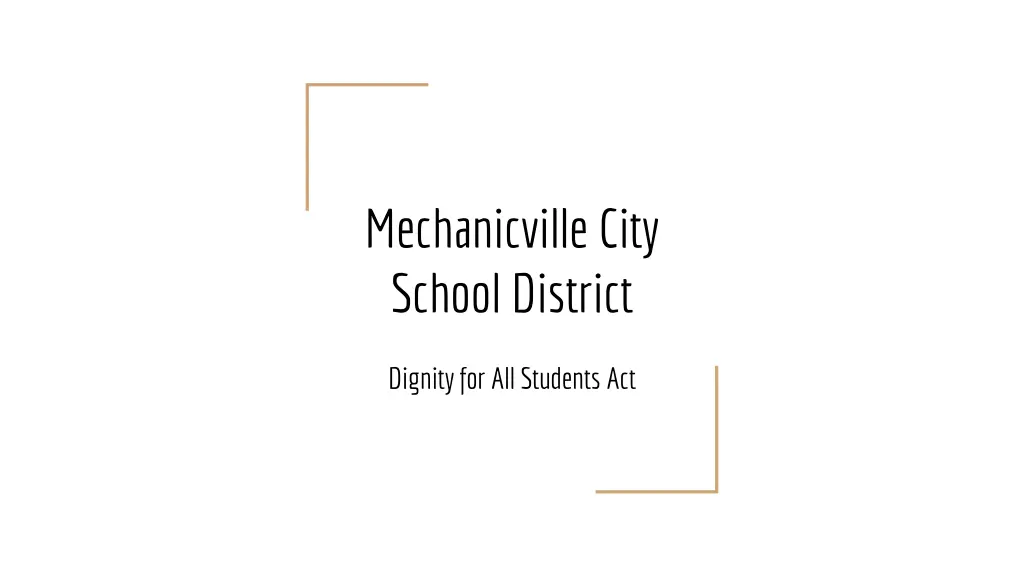
Understanding Dignity for All Students Act
Explore the Dignity for All Students Act signed into law to provide a safe and supportive environment free from discrimination, intimidation, and bullying in schools. Learn about the regulations to prevent harassment and create a positive school environment for all students.
Download Presentation

Please find below an Image/Link to download the presentation.
The content on the website is provided AS IS for your information and personal use only. It may not be sold, licensed, or shared on other websites without obtaining consent from the author. If you encounter any issues during the download, it is possible that the publisher has removed the file from their server.
You are allowed to download the files provided on this website for personal or commercial use, subject to the condition that they are used lawfully. All files are the property of their respective owners.
The content on the website is provided AS IS for your information and personal use only. It may not be sold, licensed, or shared on other websites without obtaining consent from the author.
E N D
Presentation Transcript
Mechanicville City School District Dignity for All Students Act
NYS Dignity for All Students Act Signed into law in September 2010 Became effective July 1, 2012 Amendments were made to the law August 2013 The Dignity Act seeks to provide the state s elementary and secondary school students with a safe and supportive environment free from discrimination, intimidation, taunting, harassment, and bullying on school property, a school bus, and/or at a school related function.
Dignity for All Students No student shall be subjected to harassment or bullying (including cyberbullying) by employees or students on school property or at a school function;
Dignity for All Students Nor shall any student be subjected to threats, intimidation or abuse based on his/her actual or perceived: race color weight national origin ethnic origin religion religious practice disability sexual orientation gender identity sex other
Dignity for All Students For purposes of this policy, and the implemented Code of Conduct, school property means: in or within any building, structure, athletic playing field, playground, parking lot or land contained within the real property boundary line of the District's elementary or secondary schools in or on a school bus; A school function shall mean a school-sponsored extracurricular event or activity regardless of where such event or activity takes place, including those that take place in another state
Harassment and Bullying Creating a hostile school environment by conduct, threats, intimidation or abuse (including cyberbullying), that: Has/would have the effect of substantially interfering with a student s educational performance, opportunities, benefits, or mental, emotional, or physical well being OR Reasonably causes/may cause a student to fear for his/her physical safety OR Causes or would be expected to cause physical injury or emotional harm to a student.
Emotional Harm Emotional Harm is harm to a student s emotional well-being through creation of a hostile school environment that is so severe and pervasive as to unreasonably and substantially interfere with a student s education.
Staff Reporting Responsibilities School staff are required to verbally notify the building level administrator or DASA coordinator within 1 school day of witnessing/receiving a report. A completed written report must be submitted within 2 school days of witnessing/receiving a report. Any person who has reasonable cause to suspect that a student has been subjected to discrimination, bullying, intimidation, or harassment by an employee or student, on school grounds or at a school function, who acts reasonably and in good faith and reports such information to school officials or law enforcement authorities, shall have immunity from any civil liability that may arise from making such report.
Responding If you witness it, address it immediately: Types of incidents that are occurring: Physical Contact (kicking, punching, tripping, pushing, taking belongings, spitting, etc.) Verbal Threats/Intimidation (gossiping, name-calling, put-downs, taunting, making threats) Psychological Abuse (non-verbal actions, spreading rumors, social exclusion) Cyberbullying defined as harassment or bullying though any form of electronic communication (Facebook, Twitter, texting, sexting, other social media websites.
Signs a Student is Being Harrassed Unexplainable injuries Lost or destroyed clothing, books, electronics, or jewelry Frequent headaches or stomach aches, feeling sick or faking illness Changes in eating habits, suddenly skipping meals or binge eating. Kids may come home from school hungry because they did not eat lunch. Difficulty sleeping or frequent nightmares, bedwetting Declining grades, loss of interest in schoolwork, or not wanting to go to school Sudden loss of friends or avoidance of social situations Feelings of helplessness or decreased self esteem Self-destructive behaviors such as running away from home, harming themselves, or talking about suicide
Signs a Student is Being Harrassed Not wanting to participate in extra-curricular activities Anxious, fearful, over-reactive Makes negative comments about him/herself Loses things, needs money Injuries, bruising, damaged clothing, broken things Unhappy, irritable, little interest in activities E xpresses threats to/about others Has no, or fewer, friends (isolated) Cries easily
Where is this happening? If you witness it, address it and report it: Halls Classrooms Cafeteria Field trips Playground Sidewalk Bus Gymnasium Locker Room Library Athletic Field School Events Concert On-line
Characteristics of those who harass Have little concern for others feelings Do not recognize impact of their behavior on others Are aggressive with siblings, parents, teachers, friends, and animals Are bossy and manipulative to get own way May possess unexplained objects and/or extra money Are secretive about possessions, activities, and whereabouts May hold a positive attitude towards aggression; it s fun, entertaining
Characteristics of those who harass Easily frustrated and quick to anger Come from an abusive home Come from a intolerant home Low achieving, need to feel more important; feel highly about themselves Often physically stronger Have trouble following rules Are encouraged by others, and often work in tandem May have been victims previously Have the opportunity
How to promote positive social-emotional learning in your classrooms: Stop the class when you see a bullying behavior and create a teachable moment Acknowledge students when they demonstrate empathy Teach your students to recognize bullying, victim, and bystander behaviors Promote the acceptance of differences and the value of diversity in your lessons Teach younger students the difference between tattling and telling an adult when someone needs help Help students list possible strategies when dealing with these situations Continue to be positive role models for your child/peers/students
Available Resources American Psychological Association: www.apa.org/helpcenter/bullying.aspx Anti-defamation league: www.adl.org/combatbullying/BeAnAlly.pdf Collaborative for Academic, Social, and Emotional Learning: http://casel.org Connect Safely: www.connectsafely.org Cyberbullying Research Center: www.cyberbullying.us International Bullying Prevention Association: www.stopybullyingworld.org Morningside Center for Teaching Social Responsibility: www.morningsidecenter.org National Bullying Prevention Center: www.pacerkidsagainstbullying.org


